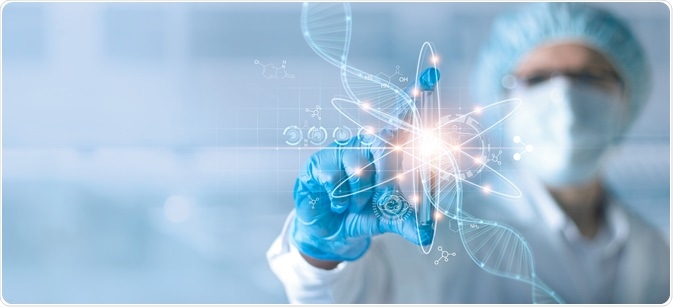Microbes are found in nearly every environment and make up much of the biomass on Earth. Vital for the continuation of life, microbes such as bacteria, fungi, and viruses have long been used by humans for several purposes. This article will discuss the use of microbes in biotechnology, a field known as microbial biotechnology.

Image Credit: PopTika/Shutterstock.com
Microbial biotechnology – an overview
Microbial biotechnology is a dynamic field, The origins of microbiology can be traced back to the pioneering research by scientists such as Louis Pasteur and Robert Koch in the 19th century. Within a few decades, increased knowledge of microorganisms and genetics made possible numerous important scientific and technological developments. Important technologies in the field of microbial biotechnology include genetically engineering microorganisms for various purposes.
The use of microbes in biotechnology has provided a wide range of products and services to a diverse number of industries. These include food production, drug development, disease prevention, and diagnostics, nutritional supplements, energy and alternative fuels, environmental monitoring and waste management, forensic sciences, and many more.
The impact of the field can be likened to the advent of modern computing and the internet. Developments in the field of genomics along with bioinformatic tools, synthetic and systems biology, imaging technology, and high-throughput single-cell techniques have provided the field with new impetus. New applications such as microbiome engineering and bioenergy made possible by microbial biotechnology promise to revolutionize society in new and exciting ways.
As mentioned above, two of the main industries that utilize microbial biotechnology in research and production are the food and medical industries. The following part of this article will briefly explain more about how these industries utilize microbes.
Microbial biotechnology and food
Humans have used microbes in the production of food for millennia. Indeed, many of the most common foodstuffs in stores have been made possible using microorganisms in their production. Bread, alcohol, cheeses, yogurts, and fermented foods such as kimchi and kombucha are all examples of foods that use microbes. Microbes used in the food industry include yeast, lactic acid bacteria, and fungi such as Penicillium roqueforti.
Microbial biotechnology has contributed to the food industry in many ways. These include the traditional fermented foods, as well as providing vitamins, polysaccharides, pigments, glycolipids, enzymes, and improving the safety and functionality of a range of common foodstuffs. Many products are already available commercially, whilst others show promise for the future. Bacteria, fungi, and algae are all commonly utilized microorganisms in the food industry.
Targeted genetic engineering of industrially viable microbial strains has provided a change in thinking in modern food production. As secondary microbial metabolites are vitally important for human health, research into the applications of microbes and biotechnology to the food industry is a global multi-billion dollar undertaking. Products derived from microbial biotechnology research are providing solutions for food security in developing countries and a world beset by climate change.
Microbial Biotechnology and life sciences
Ever since the discovery of viable antibiotics in the first half of the 20th century, the biomedical sciences and microbial biotechnology have become intrinsically linked. Several important medical advances would not have been possible without the contributions of the field to life sciences research.
Breakthroughs in molecular biology and genomics have led to an increasingly intimate understanding of human disease and the mechanisms by which it progresses. The use of genetically altered microbes has produced commercially viable drugs, vaccines, and therapeutics. E. Coli, for example, is an important expression host for the production of soluble proteins and membrane proteins. Highly purified membrane proteins are used in structure-based drugs as well as biophysical assays.
Another important contribution microbial biotechnology has provided to biomedical research is the phage library. Phages are viruses that infect and reproduce within bacteria and archaea. Phage libraries work on the principle of phage display, where a gene that encodes for a protein of interest is inserted into a virus. The protein is then expressed on the outside of the virus. Phage libraries can be constructed out of millions of target-binding proteins.
The advantage of a phage library over traditional screening techniques for antigens is that a library of different antibody sequences can be constructed, allowing for simultaneous screening. This saves a significant amount of time and resources, meaning that monoclonal antibody treatments can be brought to market much more quickly.
Novel drugs can be designed with the use of structural studies and sophisticated computer modeling. Recombinant DNA technology has led to novel immunization techniques, making once deadly pathogens treatable by clinicians. Vaccines for emerging threats can be designed and brought to market in a fraction of the time thanks to microbial biotechnology techniques.
Microbes and biotechnology – a crucial scientific revolution
These are just two of the industries that have used microbes and biotechnology to provide new products and overcome common problems. As new developments in related fields and improvements in current tools are introduced, the field of microbial biotechnology will evolve and continue to provide novel solutions well into the future. Our relationship with, and manipulation of, microorganisms is consistently intriguing.
References:
Further Reading
Last Updated: Oct 27, 2021